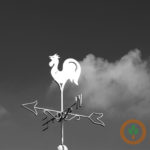
Wisconsin saw mixed precipitation and wide-ranging temperatures during February.
The USDA says the state started the month cold and snowy, turning warmer in the middle, before a storm system dropped more than a good of snow in the northeast and freezing rain and ice in the south.
Northwestern did see consistent snow cover, but other areas did not, creating concerns about winterkill for wheat and alfalfa.
While temperatures on average were warmer than normal, the wide-range did cause respiratory issues for some cattle.
